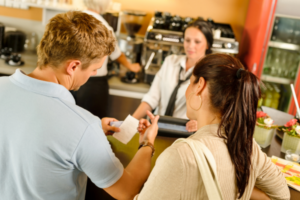
Pay wise: How to keep card surcharges down
Last updated on March 17th, 2025
You might have heard that the Australian Government is preparing to ban debit card surcharges – those pesky percentages added to seemingly every electronic transaction.
Don’t get too excited. While the Reserve Bank of Australia (RBA) is reviewing card surcharges – which cost Australians anywhere between $1 billion and $4 billion a year – any change would not come into effect until 2026.
With the average Australian shopper forking out about $140 a year in surcharges, it may not seem worth worrying about to many. But if you use your card for everything it can add up to a lot more. And if you’re counting every penny as the cost of living soars, you might want to pay more attention to what you’re doing each time you use a debit or credit card.
What surcharge can a business add?
The RBA allows businesses to pass on the merchant fees they are slugged for using electronic payments on to customers in the form of surcharges. However, there are rules governing how and what they charge you, with the Australian Competition and Consumer Commission (ACCC) overseeing the process.

Fairness
At most, a business's surcharge must be the cost of processing the card payment. This means a company cannot profit from the surcharge; it can only use it to cover the costs of accepting card payments.
Transparency
Businesses must disclose any surcharges to you before you make the payment. This could be through signs at the register, website notifications or staff communication. In cases where a business doesn't offer a surcharge-free payment option, meaning they don't accept cash and apply a surcharge to all types of card payments, the merchant must incorporate the minimum surcharge into the displayed price of its products.
What is a reasonable surcharge?
What constitutes a "reasonable" surcharge can vary depending on the type of card used. As a general guide, for payments made using debit cards like Eftpos, Visa or Mastercard, the typical costs to the merchant are between 0.5 percent and 1 percent of the transaction value. For credit cards, the costs are generally higher, typically between 1 percent and 1.5 percent.
There are also other types of surcharges. A flat fee surcharge is a fixed amount added to every transaction, regardless of the transaction size. For example, a business might add a 50-cent surcharge to all card transactions. Then there’s a tiered surcharge, that varies according to your transaction amount; for example, a business might charge a fee only for transactions less than $100.
How can I minimise card surcharges?
Ask about surcharges
Before making a payment, ask the business if they apply a surcharge for your chosen payment method. If they do, consider paying a different way that doesn't incur a surcharge or shopping at another business that doesn't apply a surcharge.
Use a different payment method
Using a cheaper payment method for the business, such as Eftpos or debit card, could result in a lower surcharge or no surcharge at all. If your card has Eftpos on it, insert your card instead of using the tap-and-go option. This method supports the lowest-cost rating, saving you more on surcharge fees.
Pay by Bank
Chemist Warehouse is one business planning to roll out QR codes to bypass transaction fees charged by the likes of Mastercard and Visa. Customers scan the QR code at the register with their phone and pay directly from their bank account. Known as Pay By Bank, it doesn’t require you to set up an account or use a third-party app. While Chemist Warehouse customers won’t save any money – the pharmacy group absorbs the card surcharges to the tune of about $15 million a year – other businesses could use it to avoid charging their customers.

Shop around or negotiate
Not all businesses apply surcharges, even if they accept credit card payments. If you're making a significant purchase, it might be worth finding a business that doesn't apply a surcharge.
In some cases, especially for larger purchases, you might also be able to negotiate the surcharge with the business. It’s worth a try.
Use cash
The old mantra of “cash is king” may no longer be true, with cards used for more than 80 percent of transactions over $10, but if you are happy to carry some with you – especially for smaller items – it is a good way to avoid surcharges. Of course, some places don’t take cash now, so be prepared.
If you feel a business is not doing the right thing or your card surcharge has been supercharged., you have the right to challenge it. Lodge a complaint with us and we will help you handle it.






